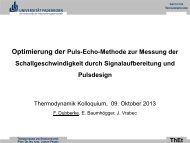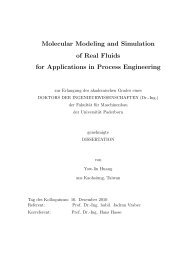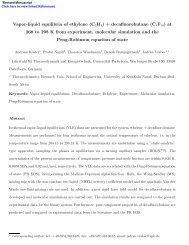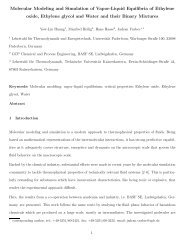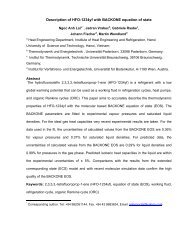ms2: A Molecular Simulation Tool for Thermodynamic Properties
ms2: A Molecular Simulation Tool for Thermodynamic Properties
ms2: A Molecular Simulation Tool for Thermodynamic Properties
You also want an ePaper? Increase the reach of your titles
YUMPU automatically turns print PDFs into web optimized ePapers that Google loves.
2. Introduction<br />
Due to the advances in computing power, methodological efficiency and the development of accurate <strong>for</strong>ce<br />
fields, it is understood that ”molecular modeling and simulation will become a breakthrough technology that is<br />
widely accepted in the chemical industry and applied in conjunction with other predictive methods to meet the<br />
industry’s evolving fluid property data needs” [1]. At the core of this prospect lies the sound physical basis of<br />
molecular modeling and simulation. It allows to adequately describe structure, energetics and dynamics on the<br />
microscopic level, which govern material properties on the macroscopic level. There<strong>for</strong>e it provides convenient<br />
access to thermodynamic properties, particularly if they are difficult or expensive to obtain by experiment, e.g.<br />
at high temperatures and pressures, or may not be measured at all, e.g. when new substances are not available<br />
in sufficient quantity. Furthermore, <strong>for</strong> toxic, explosive or in any other way hazardous substances, measuring<br />
thermodynamic properties experimentally can be unfeasible even at moderate thermodynamic conditions, while<br />
molecular modeling and simulation offers a reliable route [2].<br />
Presently, the chemical industry extends the scope of thermodynamic models that are regularly used from phe-<br />
nomenological equations of state (EOS) or excess Gibbs energy models to more advanced types, such as sta-<br />
tistical EOS like SAFT [3, 4] or continuum solvation models like COSMO-RS [5, 6]. It should be noted that<br />
all these advanced models are developed using a bottom-up approach, i.e. bridging molecular properties to the<br />
macroscopic level. These methods mainly offer access to aggregated properties, such as the Helmholtz energy of<br />
bulk fluids and its derivatives. Regarding transport properties, they are not useful.<br />
<strong>Molecular</strong> modeling and simulation is applicable with very few constraints as both static and dynamic thermo-<br />
dynamic data may be calculated, be it in bulk fluids or in confinements. Both, equilibrium or non-equilibrium<br />
conditions, may be studied. Additionally, detailed insight into the mechanisms on the microscopic level is pro-<br />
vided. This versatility, however, is associated with a substantial computational ef<strong>for</strong>t which is orders of magni-<br />
tude larger than needed <strong>for</strong> the methods mentioned above. Traditionally, molecular simulations were carried out<br />
in computing centers of national institutions or universities on powerful computing equipment, which is usually<br />
unavailable even in large chemical companies.<br />
However, with the increase in computer power, molecular simulations become feasible even off the shelf, if suit-<br />
able simulations programs are available. The scope of data accessible within reasonable times even <strong>for</strong> industrial<br />
workflows is increasing rapidly. Using molecular modeling and simulation can there<strong>for</strong>e contribute <strong>for</strong> a reduc-<br />
tion of process development time and production costs [7].<br />
<strong>Molecular</strong> modeling and simulation is rewarding, because it provides reliable predictions of essentially all ther-<br />
modynamic properties in a consistent manner [8]. <strong>Molecular</strong> models yield predictions <strong>for</strong> any property at any<br />
condition. This is of particular interest <strong>for</strong> industrial applications, where a wide variety of properties needs to be<br />
known.<br />
To further stimulate this issue, the Industrial Fluid <strong>Properties</strong> <strong>Simulation</strong> Collective [1] has organized six Simula-<br />
tion Challenges to date [8, 9, 10, 11, 12, 1]. The goal of these <strong>Simulation</strong> Challenges is to assess the capabilities<br />
of molecular methods regarding typical industrial tasks, where classical methods are insufficient.<br />
3



